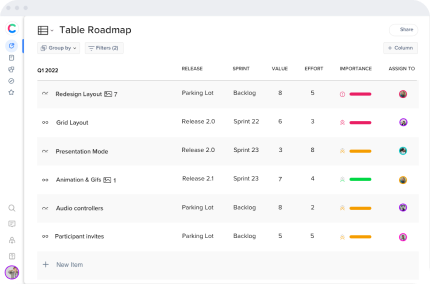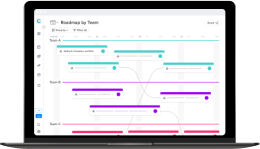Customer feedback definition: what it is and why it matters
Customer feedback is the information, opinions, and experiences that customers share about a product, service, or brand. This feedback can be positive or negative, and both types are important because they reveal customer satisfaction levels, expectations, and needs.
Companies can collect customer feedback through active methods, such as surveys and interviews, or passive methods like reviews and social media comments. In today’s data-driven world, using this feedback is no longer optional, customers expect businesses to listen, adapt, and deliver better experiences. By analyzing customer feedback and acting on it, organizations can personalize services, improve products, and build long-term loyalty.
The Importance of Customer Feedback
The software business gains the most from customer feedback investments. This is because this business is dependent on iterative product development. When compared to a physical product, a digital product may, and should, be updated and improved consistently.
Moreover, how do you determine which improvements to make? Through the incorporation of customer feedback into your product development process. One fact is particular: gathering client input proactively guarantees that you never stray too far from the requirements of your community, even as those needs change.
Feedback is a robust tool that can provide your leadership team with insights that may help them design a course forward for all aspects of their business, from product to UX and customer service. When it comes to client happiness, this is very crucial.
What is good Customer Feedback?
Customer feedback that is “good” is the feedback that your company can use to improve the product development process in the future.
In the case of color preference, a user may inform you that they prefer the color green over yellow, but this may not be something you can include in future product iterations.
Also, not always “excellent” input is the feedback that you cannot execute due to logistical or financial constraints.
You can adopt a proactive approach to collecting consumer feedback to guarantee that you receive actionable information from them.
Key Preparations for Customer Feedback Collection
Before you start asking clients for feedback, you should figure out why you want to hear from them. Identifying your targeted objectives and laying out the steps to get there lays the foundation for the profitable investment of your time and your consumers’ time.
Your input may not be helpful to anybody if you don’t have a clear goal in mind. Before you begin, write down the answers to these questions and discuss them with your team:
- What aspect of the customer experience (onboarding, content marketing) would you like to improve? Determine which customer journey elements might benefit the most from consumer insights.
- What do you intend to do with the information you’ve gathered? There’s no use in collecting client input unless it results in action. Imagine your client survey finds that your product isn’t as popular as you thought.
How to Collect Customer Feedback Effectively
You can get valuable information by using passive feedback techniques, such as scraping customer remarks left in comment areas, product evaluations, and discussion forums. This input, while organic, is typically unstructured and unrelated to any of your objectives in any way.
On the other hand, active feedback is what you actively seek from your customers and users to provide.
For example, sending out an email to your consumers asking for their input is an example of an active strategy. Active techniques are advantageous since they allow you to be more explicit about which aspects of your service you require feedback.
Taking an active approach to improving your customer feedback strategy and process is the most effective way to get results. Passive feedback, like unprompted product reviews, can be precious in and of itself.
However, to fully benefit from comments, a proactive attitude is essential.
When developing an active method for gathering feedback, You should work through the following steps:
Step 1 – Define Objectives for Customer Feedback
Make a decision on the areas of your product you want to enhance, and then carefully create questions that will elicit the feedback you’re after.
Step 2 – Identify Your Target Customers
Determine the most effective method of reaching your target audience. Customers who purchased you, consumers who bought you, customers over or under a specific age, all of your customers, etc. Decide on a target audience and make sure that they know your request for comments.
Step 3 – Keep the Feedback Process Simple
Make things as simple as possible! Customers who take the time to answer a survey, poll, or questionnaire devote their time to the activity. Develop a method that is appealing, quick, and potentially even rewarding.
Types of Customer Feedback
There are generally three main types of customer feedback: product feedback, marketing and sales feedback, and customer service feedback.
Product Feedback
When someone provides product feedback, they complement or criticize the product itself. Examples include how easy it is to use, what features your users would like to see, and whether or not certain functions work as intended.
Marketing and Sales Feedback
This feedback is in the form of a comment or critique on your marketing materials and is not confidential. For example, ensuring confidence that marketing materials are setting acceptable expectations is one way to accomplish this.
Customer Service Feedback
When someone provides customer service feedback, they share their experience with your support team or self-service resources. Examples include how quickly issues are resolved, how helpful the support staff is, or whether FAQs and help articles answer their questions.
Customer Feedback Tools and Strategy
Choosing the right customer feedback tools is essential for making the most of the data you collect. Tools should help you centralize, analyze, and act on insights. Combined with a clear customer feedback strategy, they enable companies to move from raw feedback to real improvements.
Customer Feedback Management for Success
Customer feedback is one of the most valuable resources a business can use to grow and improve. Whether it comes through product reviews, marketing responses, or customer service interactions, feedback provides direct insight into what customers need and expect.
To make the most of it, companies should set clear objectives, choose the right methods for collecting feedback, and use reliable tools to manage and analyze the results. When feedback is gathered consistently and acted upon, it helps create better products, stronger customer relationships, and long-term business success.
FAQs
What is the meaning of customer feedback?
Customer feedback is the information and opinions customers share about their experiences with a product, service, or brand. It helps businesses understand needs and improve.
Is customer feedback a KPI?
Yes. Customer feedback can serve as a KPI when measured through surveys, ratings, or reviews. It reflects customer satisfaction and guides product or service improvements.
What are the 5 reasons why feedback is important?
Feedback is important because it:
- Improves products and services
- Strengthens customer satisfaction
- Builds loyalty and trust
- Guides data-driven decisions
- Identifies opportunities for growth
How to structure customer feedback?
Customer feedback should be structured by categorizing it into themes, such as product, service, or marketing, and prioritizing based on impact and frequency.


